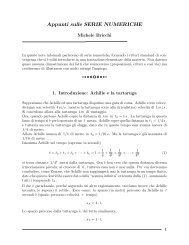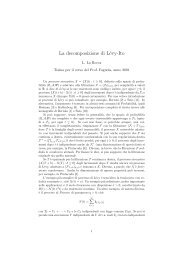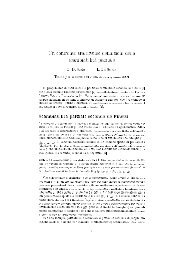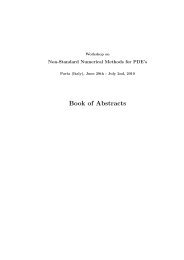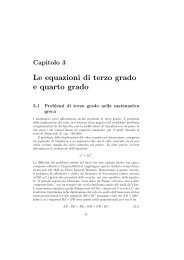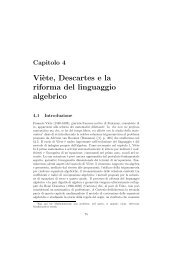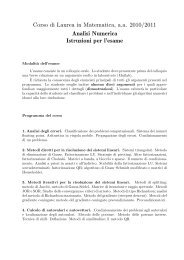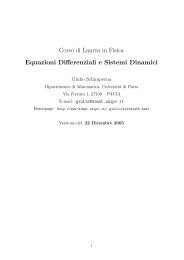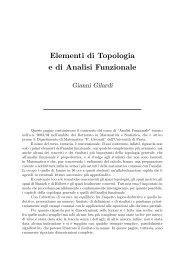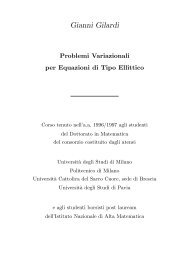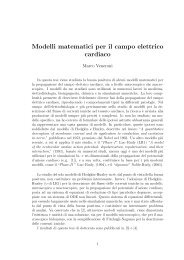G. Gilardi, Analisi Funzionale - Dipartimento di Matematica
G. Gilardi, Analisi Funzionale - Dipartimento di Matematica
G. Gilardi, Analisi Funzionale - Dipartimento di Matematica
You also want an ePaper? Increase the reach of your titles
YUMPU automatically turns print PDFs into web optimized ePapers that Google loves.
Appen<strong>di</strong>ce<br />
Capitolo III<br />
1.8. Se f = 0 tutte le con<strong>di</strong>zioni sono vere, dunque equivalenti. Sia f �= 0 . La iv) implica le<br />
altre tre. Ve<strong>di</strong>amo che ciascuna <strong>di</strong> queste implica la continuità. Fissato y0 tale che f(y0) �= 0 ,<br />
cercando x0 del tipo x0 = λy0 con λ ∈ R , troviamo x0 tale che f(x0) = α . Allora le con<strong>di</strong>zioni<br />
x ∈ Sα , x ∈ Iα e x ∈ S ′ α equivalgono rispettivamente all’appartenenza <strong>di</strong> x − x0 agli insiemi S0 ,<br />
I0 e S ′ 0 . Siccome V è vettoriale topologico, ve<strong>di</strong>amo che, ad esempio, Sα è chiuso se e solo se S0<br />
lo è. Dunque ci siamo ricondotti al caso α = 0 . Ma allora l’implicazione ii) =⇒ iv) è già nota<br />
(Proposizione 1.7) e le altre due si <strong>di</strong>mostrano in modo analogo.<br />
1.22. Il primo punto è imme<strong>di</strong>ato. Sia S la somma della serie: verifichiamo che S(I − A) = I .<br />
Se v ∈ V si ha per ogni n<br />
� n�<br />
k=0<br />
A k<br />
�<br />
(I − A)v =<br />
n�<br />
A k v −<br />
k=0<br />
n�<br />
A k+1 v = v − A n+1 v.<br />
Ma il primo membro converge a S(I − A)v in V per n → ∞ e il secondo converge a v dato che<br />
�A n+1 v� ≤ �A� n+1 �v� e �A� < 1 . Analogamente si vede che (I − A)S = I . Dunque I − A è un<br />
isomorfismo algebrico e S è il suo inverso. Infine entrambi gli operatori I − A e S sono continui.<br />
1.24. Siccome e−|λ| ≤ e−λx ≤ e |λ| per ogni x ∈ [0, 1] , la norma � · �λ<br />
massimo. Per u ∈ V , si definisca Au me<strong>di</strong>ante la formula<br />
� x<br />
equivale alla norma del<br />
(Au)(x) = k(x, y) u(y) dy, x ∈ [0, 1].<br />
0<br />
Allora Au ∈ V . Resta così definito l’operatore A : V → V , che risulta lineare, e la (1.5) si scrive<br />
come (I − A)u = f . Per concludere, basta mostrare che A è anche continuo e trovare λ che rende<br />
< 1 la norma <strong>di</strong> A , la norma in L(V ; V ) essendo quella indotta dalla norma � · �λ <strong>di</strong> V . Usiamo<br />
dunque sistematicamente la norma � · �λ , ora con λ > 0 . Per u ∈ V e x ∈ [0, 1] si ha<br />
k=0<br />
� x<br />
|(Au)(x)| ≤ |k(x, y)|e λy e −λy � x<br />
|u(y)| dy ≤ M�u�λ<br />
0<br />
ove abbiamo posto M = sup T |k| . Deduciamo che<br />
|e −λx 1 − e<br />
(Au)(x)| = M�u�λ<br />
−λx<br />
λ<br />
0<br />
e λy e<br />
dy = M�u�λ<br />
λx − 1<br />
λ<br />
≤ M<br />
λ �u�λ da cui �Au�λ ≤ M<br />
λ �u�λ .<br />
Ciò mostra che A è limitato e che �A� ≤ M/λ . Basta dunque scegliere λ > M per concludere.<br />
3.5. Posto V = L p w(Ω) , q = p ′ e Z = L q w(Ω) , scriviamo le due formule<br />
�<br />
�<br />
〈f, v〉 = zvw dµ per ogni v ∈ V e 〈f, v〉 = uv dµ per ogni v ∈ V .<br />
Ω<br />
La prima stabilisce un isomorfismo isometrico f ↔ z fra V ∗ e Z e il problema posto consiste<br />
nel vedere in quale spazio X del tipo L q<br />
∗(Ω) lasciar variare u in modo che la corrispondenza fra<br />
w<br />
f ∈ V ∗ e u ∈ X stabilita dalla seconda formula sia un isomorfismo isometrico fra V ∗ e X . Dato<br />
quanto abbiamo detto riguardo alla prima formula, la scelta obbligata è la seguente<br />
X = {zw : z ∈ Z} e �u�X = �z�q,w se z ∈ Z e u = zw<br />
e il problema si sposta nella caratterizzazione <strong>di</strong> X e <strong>di</strong> � · �X . Per u = zw con z ∈ Z si ha<br />
�z� q �<br />
q,w = |z| q �<br />
w dµ = |u| q w 1−q �<br />
dµ = |u| q w ∗ dµ = �u� q<br />
q,w∗ 234<br />
Ω<br />
Ω<br />
Ω<br />
Ω<br />
Gianni <strong>Gilar<strong>di</strong></strong>



